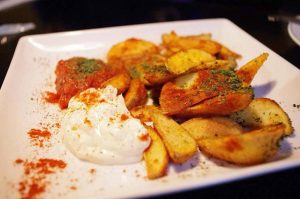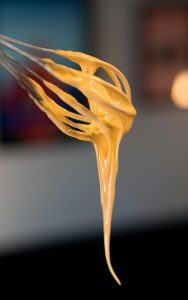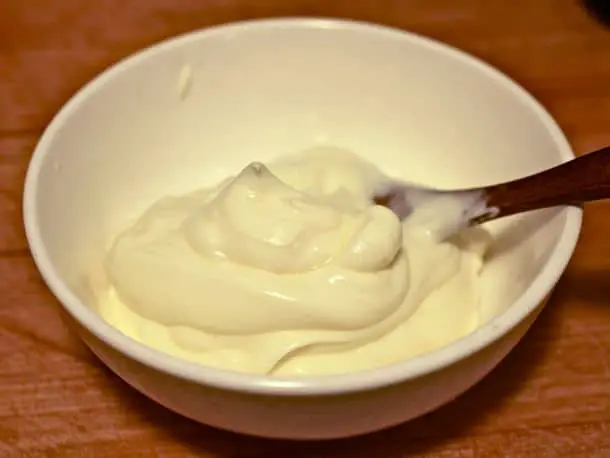Some condiments are used during cooking to add flavor or texture, while others are added to meals to enhance the zest. Mayo is one of such condiments that are added to foods to bring a unique flavor.
It’s used so extensively that eating is incomplete without it! Imagine taking a bite of a hamburger or a spoonful of salad without Mayo dressing. We’re sure you’ll feel incomplete because it will lack in that creamy, smooth, and slightly tart flavor.
Like eating a hamburger, many other meals, cooked or uncooked, remain incomplete without Mayo. However, despite its popularity, many people are unsure about what it’s made of and how it’s produced, and more importantly, why is this creamy sauce so irresistible?
What is Mayonnaise made of?
Mayonnaise, popularly known as Mayo, is a condiment made from assorted items like oil, egg yolk, a few drops of vinegar or lemon juice, salt, and a dab of mustard.
The French chef of the Duc de Richelieu first created this savory, creamy sauce after the Duc beat the British at Port Maon in 1756. His victory feast included a sauce made from cream and eggs but realizing that there isn’t any cream in his kitchen, he substituted it with olive oil and gave the sauce the name of “Mayonnaise.”
It’s often used as a sauce such as a dipping sauce; hence many people refer to Mayo as a sauce instead of a condiment.

Technically, it’s prepared as an emulsion of oil and egg yolk. It’s emulsified because oil and egg yolk doesn’t easily mix. To mix egg yolk and oil together, you’ll have to integrate them slowly and whisk constantly.
Mayo is made by combining lemon juice or vinegar with egg yolks. Eggs are mainly used because they contain the emulsifier lecithin. An emulsifier helps bring two liquids together and prevent separation.
Then, you’d need to add oil drop by drop into the mixture. Adding oil too quickly or too little will keep the two liquids from combining. But, as the mixture begins to thicken, you can start adding oil more rapidly.
Seasonings are whisked into the mixture after all of the oil has been added.
Homemade Mayonnaise is uncooked; hence it will only last for few days in a refrigerator. Commercial Mayonnaise that you usually find in the Supermarket can last for up to six months or more.
How do you make mayonnaise from scratch?
Here is how you can prepare a fail-Proof homemade mayonnaise.
Preparation Time: 5 minutes, Quantity: 1 cup, Equipment: Whisk and bowl
Ingredients needed for Mayo
- Two large eggs
- Two teaspoons fresh lemon juice
- Alternatively, you can use vinegar
- 1 cup of neutral-flavored oil (Olive oil, grape seed oil, walnut, or sweet almond oil)
- A pinch of salt, regular or kosher salt

Steps to make mayonnaise in 5 minutes
- Start with separating the egg whites from the yolk. Mayo doesn’t use egg whites, so you’d need to extract the yolks carefully.
- Pour the fresh lemon juice into the bowl with the egg yolks and start whisking.
- Once you whisk them well, you can introduce oil into the mixture. Slowly pour the oil into the bowl while whisking constantly.
- Don’t forget to keep whisking for emulsification because once you stop whisking, the two liquids will separate.
- When the oil starts to build up, stop pouring it but keep whisking it briskly until the oil has been incorporated.
- The result should be thick and fluffy, with your whisk forming ribbons through the mixture. (If your solution looks too thick, add enough water to thin it out. Add a teaspoon of water at a time.)
- Once all the oil has been mixed in, season it carefully with salt.
Few things to keep in mind
- Use pasteurized eggs to prevent salmonella bacteria that can cause foodborne illness.
- Use room temperature eggs as cold eggs often result in an unthickened mixture.
- Always add lemon juice first to help break down the protein in the egg yolk. Use only fresh squeezed lemon juice.
- Start with a slower stream of oil, a few drops at a time. You can ask your family member or assistant to pour it while you keep whisking the mixture.
Here is a video by Jamie Oliver and his beautiful Mayo Recipe
How does Mayo taste?
Different people have different ways of explaining the taste of Mayo. Still, many chefs and food connoisseurs would agree that the Mayo tastes smooth, creamy, lightly tart, tangy, and gloppy when eaten directly.
It’s hard to determine Mayo’s taste when you mix it with food because it helps bring the taste together instead of giving an individual flavor.

Mayo vs. Mayonnaise vs. Vegan Mayo
Many people often inquire, “Is real Mayo the Mayonnaise?”
The answer is Yes! The real mayo is mayonnaise. The term Mayo is a just short form for mayonnaise,
Many manufacturers use the term “just Mayo” to refer to eggless and plant-based mayonnaise; however, both real mayo and just mayo are traditionally produced mayonnaise with the use of egg.
On the other hand, Vegan mayo is made with only six ingredients, namely tofu, oil, lemon, vinegar, dijon, and salt.
Although a vegan delight, many food lovers have switched from regular mayo to vegan mayo because it’s healthier. Vegan mayo contains less saturated fats and cholesterol. People who have switched to vegan mayo often claim that it’s sweeter than regular mayo.
So, can vegans eat mayo?
Certainly, vegans can consume vegan mayo made from plant-based ingredients without the use of egg yolks.
Does Mayo have milk?
Do many food lovers also inquire if mayo contains milk or dairy product? Regular mayo does not use any dairy products, so it doesn’t have milk. People with dairy allergies can consume mayonnaise without any worries.
Milk-based mayonnaise, on the other hand, contains dairy products. A famous Portuguese mayo made with whole milk, lemon juice, oil, and spices is a dairy substitute for regular mayo.
Is Mayo Gluten-Free?
Yes, regular mayo is gluten-free because it’s typically made from naturally gluten-free ingredients such as eggs, oil, vinegar, and lemon.
That being said, not every packaged mayo that you find in the market is gluten-free. Some mayo may contain recipes that were derived from gluten-containing products or have been at risk of cross-contamination with gluten during the production.
To ensure that your mayo is gluten-free, consider checking the label. It should generally read “gluten-free,” “no gluten,” “free of gluten,” or “without gluten.” All gluten-free products contain fewer than 20 parts per million (ppm) of gluten.
When you’re at a restaurant, check with a server to determine whether their mayo is gluten-free.
White Mayo vs. Yellow Mayo, Why do I see different colored Mayo?
White mayo is a regular mayonnaise that contains a less amount of egg yolks and more water. The store brought mayo to be whiter than homemade mayonnaise because they add water to the mixture rather than relying on the moisture in the egg yolks and vinegar.
Some stores brought mayo to use whole eggs instead of just yolks, giving it a distinct white color and cheap quality.
If you make a regular mayo at home using just egg yolks, your mayonnaise will be comparatively yellowish.
You could also find yellowish-orange mayo, which results from ‘paprika oleoresin’ added to regular mayo.
Is Aioli the same as the Mayo?
Although Aioli and mayo are both creamy emulsions, aioli sauce is made from emulsifying garlic and olive oil instead of eggs. However, the final result may look similar, which often confuses food lovers.
WebstaurantStore.com puts it as
Aioli, meaning “garlic oil” in Catalan, is a sauce made by emulsifying mashed garlic with extra virgin olive oil, typically with a mortar and pestle.
It’s made by pounding several garlic cloves into a paste and then slowly introducing olive oil as you keep stirring the mixture.
Nowadays, the word aioli is pretty much synonymous with mayo, but it isn’t mayo. Both the sauces have distinctly different flavors—many call aioli as fancy flavored mayo or elaborately seasoned mayo.
Aioli is a popular alternative for mayo and is fervently used to spread sandwiches, dips for chips, sauce for shellfish, and grilled lamb.
How to use Mayo as a Cooking hack?
Mayo can be used in many unexpected cooking applications to take its flavor to another level.
Here are some fantastic cooking hacks with mayonnaise for you.
- Add it to cake batter to make your cakes super moist.
- Brush meat with mayo before cooking to prevent it from sticking to the grill.
- Fry your grilled cheese in mayo instead of butter to get that crispy golden crust.
- Add it to the flour batter to make fluffy biscuits.
- Mix it with mashed potatoes to make them creamy and rich.
- Rub chicken with mayo before roasting it to give a beautiful golden texture.
- Dip chicken breasts into mayo before dipping it into breadcrumbs to make a crispy breaded chicken breast without using flour or eggs.
- Use it to create a creamy cheese spread for melting on top of garlic bread.
- Mix it into lean ground meat to produce a super moist and fatty meal.
- Use mayo to prepare a quick Alfredo sauce.
- Add it to scrambled eggs instead of milk or water.
Is mayo bad for me?
Yes, only if you eat it in a significant amount. Be wary about overeating mayo because a tablespoon contains up to 90 calories and 10g fat, the latter of which is 15.4% of your daily recommended intake. It’s high in fat but not saturated fat, which can harm your health if consumed a lot.
Also, in some cases, when the preparation and storage of mayo are not done correctly, it leads the way for bacteria to breed. The presence of cheap vegetable oils can make it more fattening!
Mayo is the most loved creamy condiment around the world. You can basically put it on anything, including salad dressings, the base for sandwiches, and mixed with herbs and other sauces to create dips.
If you’re a vegan, you can easily find the all-vegan products in the market or make one at home with few steps. Don’t forget to store it at a cool temperature and eat in moderation.
